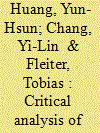|
|
|
Sort Order |
|
|
|
Items / Page
|
|
|
|
|
|
|
| Srl | Item |
| 1 |
ID:
117004


|
|
|
|
|
| Publication |
2012.
|
| Summary/Abstract |
This paper empirically investigates factors driving the adoption of energy-efficiency measures by small and medium-sized enterprises (SMEs). Our analyses are based on cross-sectional data from SMEs which participated in a German energy audit program between 2008 and 2010. In general, our findings appear robust to alternative model specifications and are consistent with the theoretical and still scarce empirical literature on barriers to energy-efficiency in SMEs. More specifically, high investment costs, which are captured by subjective and objective proxies, appear to impede the adoption of energy-efficiency measures, even if these measures are deemed profitable. Similarly, we find that lack of capital slows the adoption of energy-efficiency measures, primarily for larger investments. Hence, investment subsidies or soft loans (for larger investments) may help accelerating the diffusion of energy-efficiency measures in SMEs. Other barriers were not found to be statistically significant. Finally, our findings provide evidence that the quality of energy audits affects the adoption of energy-efficiency measures. Hence, effective regulation should involve quality standards for energy audits, templates for audit reports or mandatory monitoring of energy audits.
|
|
|
|
|
|
|
|
|
|
|
|
|
|
|
|
| 2 |
ID:
116967


|
|
|
|
|
| Publication |
2012.
|
| Summary/Abstract |
The diffusion of cost-effective energy-efficiency measures (EEMs) in firms is often surprisingly slow. This phenomenon is usually attributed to a variety of barriers which have been the focus of numerous studies over the last two decades. However, many studies treat EEMs homogenously and assume they have few inherent differences apart from their profitability.
We argue that complementing such analyses by considering the characteristics of EEMs in a structured manner can enhance the understanding of EEM adoption. For this purpose, we suggest a classification scheme for EEMs in industry which aims to provide a better understanding of their adoption by industrial firms and to assist in selecting and designing energy-efficiency policies.
The suggested classification scheme is derived from the literature on the adoption of EEMs and the related fields including the diffusion of innovations, eco-innovations and advanced manufacturing technology. Our proposed scheme includes 12 characteristics based on the relative advantage, the technical and the information context of the EEM. Applying this classification scheme to six example EEMs demonstrates that it can help to systematically explain why certain EEMs diffuse faster than others. Furthermore, it provides a basis for identifying policies able to increase the rate of adoption.
|
|
|
|
|
|
|
|
|
|
|
|
|
|
|
|
| 3 |
ID:
149964


|
|
|
|
|
| Summary/Abstract |
The cement industry is the second most energy-intensive sector in Taiwan, which underlines the need to understand its potential for energy efficiency improvement. A bottom-up model-based assessment is utilized to conduct a scenario analysis of energy saving opportunities up to the year 2035. The analysis is supported by detailed expert interviews in all cement plants of Taiwan. The simulation results reveal that by 2035, eighteen energy efficient technologies could result in 25% savings for electricity and 9% savings for fuels under the technical diffusion scenario. This potential totally amounts to about 5000 TJ/year, of which 91% can be implemented cost-effectively assuming a discount rate of 10%. Policy makers should support a fast diffusion of these technologies. Additionally, policy makers can tap further saving potentials. First, by decreasing the clinker share, which is currently regulated to a minimum of 95%. Second, by extending the prohibition to build new cement plants by allowing for replacement of existing capacity with new innovative plants in the coming years. Third, by supporting the use of alternative fuels, which is currently still a niche in Taiwan.
|
|
|
|
|
|
|
|
|
|
|
|
|
|
|
|
| 4 |
ID:
116763


|
|
|
|
|
| Publication |
2012.
|
| Summary/Abstract |
We analyze the change of energy consumption and CO2 emissions in China's cement industry and its driving factors over the period 1990-2009 by applying a log-mean Divisia index (LMDI) method. It is based on the typical production process for clinker manufacturing and differentiates among four determining factors: cement output, clinker share, process structure and specific energy consumption per kiln type. The results show that the growth of cement output is the most important factor driving energy consumption up, while clinker share decline, structural shifts mainly drive energy consumption down (similar for CO2 emissions). These efficiency improvements result from a number of policies which are transforming the entire cement industry towards international best practice including shutting down many older plants and raising the efficiency standards of cement plants. Still, the efficiency gains cannot compensate for the huge increase in cement production resulting from economic growth particularly in the infrastructure and construction sectors. Finally, scenario analysis shows that applying best available technology would result in an additional energy saving potential of 26% and a CO2 mitigation potential of 33% compared to 2009.
|
|
|
|
|
|
|
|
|
|
|
|
|
|
|
|
| 5 |
ID:
132742


|
|
|
|
|
| Publication |
2014.
|
| Summary/Abstract |
Turkey's energy demand has been growing by 4.5% per year over the last decade. As a reaction to this, the Turkish government has implemented the Strategic Energy Efficiency Plan (SEEP), which provides a guideline for energy efficiency policies in all sectors.
The aim of this study is to analyse the potential of the SEEP on final energy demand in the Turkish residential sector until 2030. Three scenarios are developed based on a detailed bottom-up modelling approach using a vintage stock model to simulate the energy demand of heating systems and appliances.
The results show a decreasing final energy demand in the reference scenario from about 944 PJ in 2008 to 843 PJ in 2030. This reflects a structural break, which is mainly caused by a high building demolition rate and low efficiency in the existing building stock. The SEEP achieves additional savings of around 111 PJ until 2030, while a scenario with even higher efficiency shows further savings of 91 PJ. Electricity demand increases in all scenarios - mainly due to growing ownership rates of appliances. The SEEP will achieve around 10 TWh of electricity savings in 2030 compared to the reference scenario, mainly through more ambitious end-use standards.
|
|
|
|
|
|
|
|
|
|
|
|
|
|
|
|
|
|
|
|
|